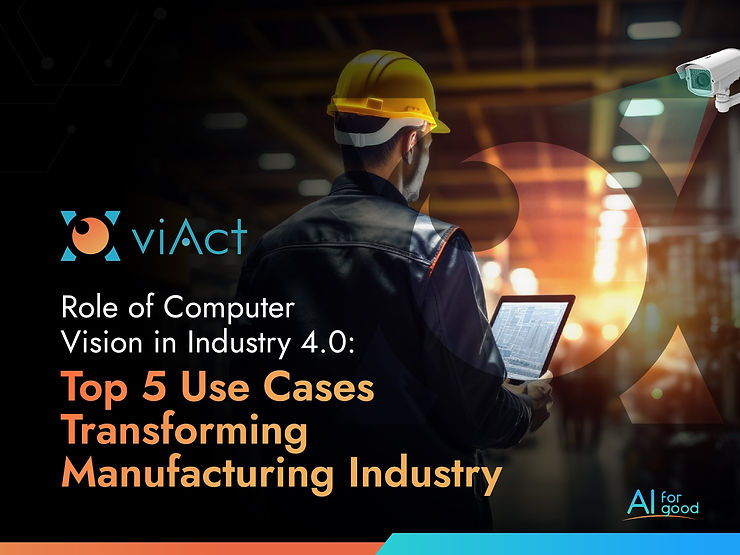With the advent of Industry 4.0, the rapid transformation in industries makes Computer Vision in Industry 4.0 a powerful instrument for increasing productivity and optimizing operations. Manufacturers and industrial sectors make use of real-time data, automation, and advanced monitoring systems through AI, machine learning, and the Internet of Things. This enhances efficiency, and safety, and reduces the costs of operations. Some of the most prominent applications of Computer Vision in Industry 4.0 and the future directions for changing the faces of modern industries.
PPE Detection for Worker Safety
Employee safety is one of the areas companies in the construction, manufacturing, and oil and gas industries are constantly improving on. Computer Vision in Industry 4.0 permits AI-based systems to check how well PPEs are being used. Cameras across sites deployed can detect if workers are properly fitted with required PPEs, such as helmets, gloves, or harnesses. In the event of a violation, the worker and officers involved are immediately messaged to address the transgression. Real-time monitoring in such cases reduces injury rates sharply at the workplace, but companies can comply with regulatory standards and protect their people.
Automated Product Inspection
Product quality control is another area where Computer Vision in Industry 4.0 can very significantly make a difference. AI-driven video analytics systems can inspect products on the production lines in real time so that defects or damaged products can be detected much more precisely than by human beings. This ensures that faulty products are identified and isolated at once so that the chances of faulty items reaching the customers are minimized with improvement in the quality of products overall.
Automated product inspection, in particular, is valuable in industries like electronics, automotive, and pharmaceuticals, where an imperceptible defect may mean a serious mishap. In fact, because these machines are designed to inspect large quantities, the result is increased output while still maintaining high standards of quality.
Forklift and Machinery Monitoring
The safe operation of machinery and automobiles like forklifts is one major phenomenon within industries. In Industry 4.0, Computer Vision is applied to monitor the real-time behavior of forklifts such as speed load and collision detection. The operators would be required to adhere to the safety protocols and accidents are finally reduced. Furthermore, AI systems can identify any abnormal conditions like overheating or overloading of machinery and provide instant alerts for preventive measures.
Inventory and Stock Management
Computer Vision in Industry 4.0 has changed the way of inventory and stock management by automating product counting and stock alerts. AI-enabled cameras track the products within a warehouse and assembly line, making sure that the records of the inventory are updated in real time. Thus, this automation system reduces the probability of human errors and ensures that the stock levels are always correct. Furthermore, the system enables automated alerts of running out of stock, hence allowing timely replenishment.
Fire and Smoke Detection
This particular area of industrial through fire and smoke detection using Computer Vision in Industry 4.0, it has been a game-changer. AI-powered cameras detect smoke and fire at the point of the initial incident, giving advanced warnings that prevent damage that may prove to be catastrophic. These warnings directly reach safety officers who take immediate action to contain the situation.
Advanced monitoring systems assist industries like oil and gas, manufacturing, and mining in lowering the more significant threat of fire. This reduces the risks to and losses for the workers and valuable assets and hence protects operations continuity and safety.
Conveyor Belt and Assembly Line Monitoring
The conveyor belt systems run as the lifeblood of most industrial processes. Failure in the line or any malfunction in it results in costlier delays and downtime. Computer Vision in Industry 4.0 involves constant monitoring of conveyor belts for blockages and breakdowns or issues. Once a problem is detected, AI triggers an alert to the maintenance team to address the problem before escalations occur.
Conclusion
As industries witness more and more acceptance of Computer Vision in Industry 4.0, the level of productivity goes up, safety becomes a comparative issue, and efficiency quite matches expectations. These applications now go from detecting PPE to forklift monitoring, from automated product inspection to inventory management. Through AI and video analytics, industries are streamlining their operations and creating safer and more efficient workplaces at the same time. It portends a very promising future, with greater competitiveness and productivity, as companies continue to adopt these advanced technologies.
Visit Our Social Media Details :-
Facebook :- viactai
Linkedin :- viactai
Twitter :-aiviact
Youtube :-@viactai
Instagram :-viactai/
Blog Url :-
The Future of Project Control Centers: AI Video Analytics Role in Smart Construction
AI Video Analytics for Smart Manufacturing: 5 Ways viAct Digitizing Future Factories in Saudi Arabia

No comments:
Post a Comment